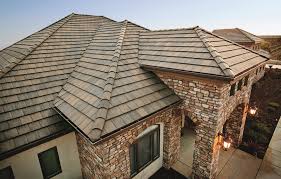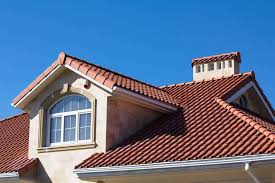How Missing Roof Tiles Lead to Serious Leaks
Tiles protect the roofs’ waterproofing barrier, the underlayment, from the elements, like the sun (an especially harsh element in Phoenix) and underlayment exposed directly to the sun’s harmful UV rays will quickly deteriorate. Deteriorated underlayment from a cracked and tile on your roof. Once it’s deteriorated, there’s nothing stopping water from getting into your home and causing serious damage!
Common Reasons Tiles Fall Off Your Roof
Shoddy Installation
How tile is attached to your roof depends on the slope of the roof, the manufacturer of the tile and the type of tile installed. It could be that when your tile roof was installed, it wasn’t installed as it should have been. If your home or tile roof is new (less than 10 years old), this is the most likely cause.
What to do: If your roof is still under warranty, contact the builder, installer or roofing manufacturer. They should be able to make it right.
If you’re outside of the warranty period, contact a trusted roofer to fix the missing tiles and make sure there aren’t any other problems with your roof. (Most new homes come with a 2-year warranty).
Walking on Your Roof
When you walk on a tile roof, you can crack the tiles and/or cause them to work loose from the nails that hold them to the roof. If you have a clay tile roof, you should never walk on it! Clay tiles crack easily. Concrete tile is more forgiving, but you still need to be careful.
What to do: Replace the missing tiles on your roof and avoid walking on the roof more in the future.
Extreme Weather
Most Arizona tile roofs aren’t built to withstand extreme weather; we just don’t get that much of it. So when it does happen, the extreme wind can catch a tile and blow it off the roof. Tiles on the ridge and eaves of the roof are especially susceptible to wind.
What to do: Contact a professional roofer to assess the damage of the roof. Even though it might just look like a few missing tiles, there could be more damage than you can see.

Does My Tile Roof Need to Be Replaced?
Are you noticing that there are more than a few problems with your roof? If you have leaks in several places, terrible air circulation in your attic, and are noticing some cracked, damaged, or even missing tiles in multiple locations, you’re probably facing one of the toughest questions that a homeowner will ever have to face: is it time to completely replace my roof or can I simply repair it and keep it going a little while longer.
Let’s face it: replacing your roof is a huge expense, and it’s not one that most people look forward to having to take on. A new roof costs thousands of dollars, and that’s a lot of money that many people don’t exactly have sitting around. So, logically, you want to get the most you can out of the roof that’s over your head already before having to fully replace it. But how do you know when it’s the right time to actually make the jump and get a full replacement? To help you make that determination, here are a few questions you can answer about your roof and what they say about whether you should consider replacing or repairing it.
Roof Age
The first and most important question as to whether you should repair or replace is how old the roof over your head is. If your roof is still within its normal average service life, then you can probably get away with repairing it, especially if the issues aren’t seriously jeopardizing your roof’s integrity. Generally, your roof’s average service life depends on the type of material it’s constructed from—clay or concrete tiles can usually last 20 to 30+ years, and potentially even longer as long as they’re well-maintained and small problems aren’t allowed to sit and grow.
Visible Condition
A brief inspection of your roof can tell you whether or not you should consider replacing or repairing your roof. First, take a quick look from the outside, which you can usually do from the curb right in front of your home. Do you see any tiles which are cracked, badly damaged, or even missing? These are signs of a serious weakness in your roof that could be jeopardizing the materials underneath. If this kind of damage is in several spots, then you probably need to replace your roof, especially if these spots have been exposed for several months and seen rainfall.
Future Plans
There’s one last thing to consider when deciding whether or not you wish to replace your roof: are you selling your home anytime soon? Potential homebuyers will be extremely concerned about the condition of your roof, and nothing kills a deal or drives away interested buyers quicker than finding out the roof over a home needs significant work or replacement. Even if the home is priced extremely low and positioned to sell, you’ll find it really difficult to sell your home if the roof is in bad shape.

Roof Tile Installation and Repair
Installation and repair of tile roofs is best left to professional roofers with local experience working with tile. Under normal circumstances, tile roofs are virtually maintenance free. However, the ultimate longevity of a tile roof depends on the quality of all elements of the roofing system. For example, many leaks are caused not by tile failure but by damaged or inferior underlayment or flashing. If this occurs, qualified tile roofers can remove the roof tiles, address the cause of the problem, and then replace the tiles intact.
Walking on a tile roof can damage tiles, if not done properly. Even though tile is one of the most durable roofing products available and hardens with age, walking carelessly on it can cause breakage.

Benefits of Tile Roofing
Tile roofing is one of the oldest roofing methods in existence. With proper maintenance, tile roofs can last over 50 years, in addition to these incredible benefits:
- Tile is weather-resistant
- Tile will withstand high winds
- Tile resist hail strikes
- Tile is pest-resistant
- Tile has the highest fire protection rating possible
- Tile helps reduce energy costs
- Tile requires minimal maintenance
- Tile is environmentally friendly
- Tile has many style and color options
Common Tile Roof Repairs
Slipping: Delaminating / Sliding
Tile roofs with a #30lb felt paper base and a #90lb hot asphalt installed underlayment system is installed and the tiles adhered using mortar add extra weight to the system. During our hot months, the roof temperature rises above 160 degrees and softens up the asphalt adhesive. With extra tile weight and without enough fasteners to hold the tiles to the deck, the roof system could slide, especially on high-pitched roofs. There is no way to repair this issue – it is a sign that replacement is near.
Backwater Laps
When installing a roof system it is important to always start at the lowest point and proceed upward toward the roof’s peak. This ensures each layer of materials overlaps the previous. Even on flat roofs, this principle is important. As water travels, whether on a pitched or flat roof, if two seams are lapped in backward a backwater lap occurs. This can “cup” water and force in under the layers, causing leaks.
Off Ridge Vents not Angled
Vents are installed on the roof to allow for attic airflow. These vents should not be longer than four feet in length and should be installed at an angle. As water flows down the roof it often is blocked behind the vent creating a small area of water ponding. Ponding water is water sitting on any asphalt roofing material longer than 48 hours without run-off or evaporation. As the water sits it magnifies the sun’s rays and works on breaking down the sealant and underlayment used to seal the vent to the roof. The correct way to fix this issue is to install a new vent.
Flashing Seams Separating
Flashing seams must be overlapped correctly and an adequate amount of sealant placed in between the overlap area to ensure proper waterproofing at the ell flashing transition area. Here, Ell flashing seams were separating and in need of additional sealant. The correct way to repair this area is to replace the flashing with new. That is the only way to ensure the flashing detail area will not leak.
Tile Roof Cemented
Tile used to be installed using a single patty of mortar cement placed on the roof and the tile embedded therein. Although installation techniques required each tile to be submerged in water prior to installation, this was rarely ever followed. Each tile was set in place and left to dry. Over time and movement, the tile breaks loose from the mortar and does not re-adhere. The temporary solution is to lift each tile and spray roof tile adhesive under it to create a new bond. However, this is labor-intensive. If not repaired, the roof tiles may easily dislodge and become airborne during a high wind event.